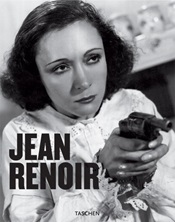(Taschen Books, 192 pages, $24.99)
By Christopher Faulkner
 Jean Renoir’s career, wrote Andrew Sarris, is a river of personal expression. With all the water imagery in his movies—from 1951’s The River, to Boudu Saved from Drowning (1932) and the melancholy shot of the receding stream in A Day in the Country (1936)—Renoir’s filmmaking always displayed certain aquatic tendencies. As Christopher Faulkner writes, the director’s worldview could not be contained by conventional barriers, be they genre distinctions, spatial limitations or class differences, and often simply flowed right over them.
Jean Renoir’s career, wrote Andrew Sarris, is a river of personal expression. With all the water imagery in his movies—from 1951’s The River, to Boudu Saved from Drowning (1932) and the melancholy shot of the receding stream in A Day in the Country (1936)—Renoir’s filmmaking always displayed certain aquatic tendencies. As Christopher Faulkner writes, the director’s worldview could not be contained by conventional barriers, be they genre distinctions, spatial limitations or class differences, and often simply flowed right over them.
In his most fertile period, the Popular Front years in the 1930s, when he made 15 films, his settings ranged from the top of the social ladder (Rules of the Game, 1939) to the very bottom (The Lower Depths, 1936) to depict French society in a way that would have made Balzac proud. Renoir’s sense of space was no less fluid, as his smoothly mobile camera swam elegantly through his complex sets, with deep-focus cinematography layering and complicating his compositions.
In his peak years, Renior worked in nearly every genre besides science fiction and even created a foreshadowing of Italian neorealism, particularly in Toni (1935) (Visconti was his assistant on the film). And in his working methods, Renoir adopted the familial sense of creativity that characterized his aristocratic-bohemian childhood—peopling his crews and his films with the same friends, lovers, wives, and family members who filled his off-screen existence. The result was an atmosphere of organic naturalism, of life extending beyond the frame. Anna Magnani’s question in The Golden Coach (1953)—“Where does theater end and life begin?”—is an essential component of Renoir’s art and humanism.
Within these parameters, Faulkner delivers a compact yet comprehensive survey of one of the great careers in cinema history. Succinctness is key to Taschen’s series of director profiles, aiming to show a life in one clear, wide-angle shot, with frequent close-ups when necessary. Faulkner divides Renoir’s career into four sections: the silents through 1929; the above-mentioned Popular Front of the ’30s; a wartime detour to Hollywood and the postwar color pictures. Perhaps best of all for a director of Renoir’s visual grace are the numerous images—production sketches, frame enlargements, paintings of the director by his impressionist father Pierre-Auguste, movie stills and even pages from Renoir’s FBI file. Renoir directed 40 films, but as he was fond of saying—and this worthy volume reminds us—“a director makes only one movie in his life.
Review written by John Patterson.